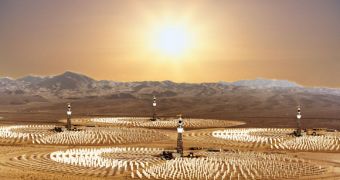Photovoltaic cells, as the word implies (photo = light, voltaic = electricity), convert sunlight directly into electricity. Once used almost exclusively in space, photovoltaics are used more and more in less exotic ways.
They could even power your house, but they are more widely used for satellites and spacecrafts, and, for the moment, their efficiency could use some improvements.
That's why a research sponsored by the U.S. Air Force Office of Scientific Research created a revolutionary system of 3D solar cells.
The new 3D solar cells capture photons from sunlight using an array of miniature "tower" structures that resemble high-rise buildings in a city street grid.
They trap light between their tower structures, which are about 100 microns tall, 40 microns by 40 microns square, 10 microns apart - and built from arrays containing millions of vertically-aligned carbon nanotubes. Conventional flat solar cells reflect a significant portion of the light that strikes them, reducing the amount of energy they absorb.
Because the tower structures can trap and absorb light received from many different angles, the new cells remain efficient even when the sun is not directly overhead. That could allow them to be used on spacecraft without the mechanical aiming systems that maintain a constant orientation to the sun, reducing weight and complexity - and improving reliability.
3D photovoltaic cells present multiple advantages: they absorb virtually all of the light that strikes them, their coatings can be made thinner, allowing the electrons to exit more quickly, thus increasing the rate at which absorbed photons are converted to electrons, as well as reduced size, weight and mechanical complexity.
"Our goal is to harvest every last photon that is available to our cells," said Jud Ready, a senior research engineer in the Electro-Optical Systems Laboratory at the Georgia Tech Research Institute (GTRI). "By capturing more of the light in our 3D structures, we can use much smaller photovoltaic arrays. On a satellite or other spacecraft, that would mean less weight and less space taken up with the PV system."
However, there are still some technical issues, like their ability to survive launch and operation in space, and the fact that production techniques will have to scaled up from the current two-inch laboratory prototypes.
But the cells could find near-term applications for powering spacecraft, and by enabling efficiency improvements in photovoltaic coating materials, could also change the way solar cells are designed for a broad range of applications.

 14 DAY TRIAL //
14 DAY TRIAL //